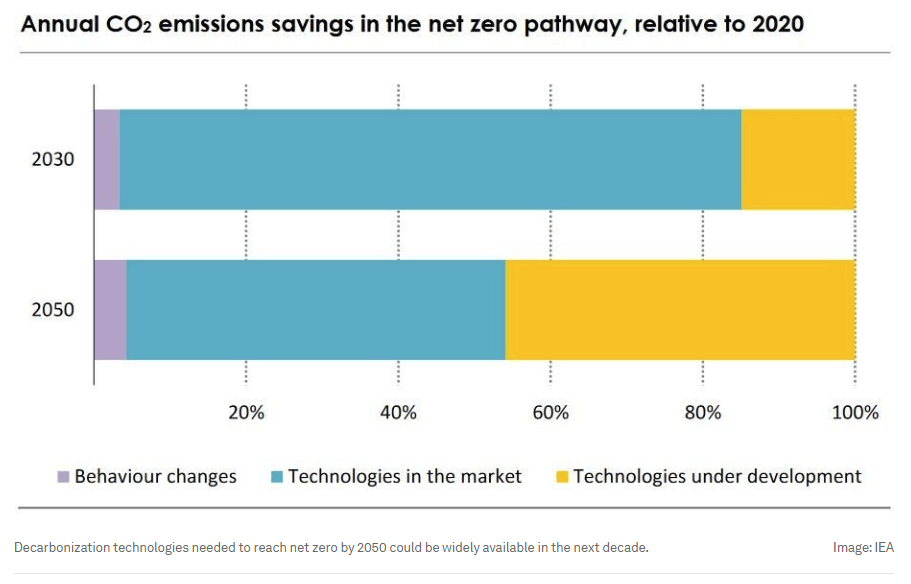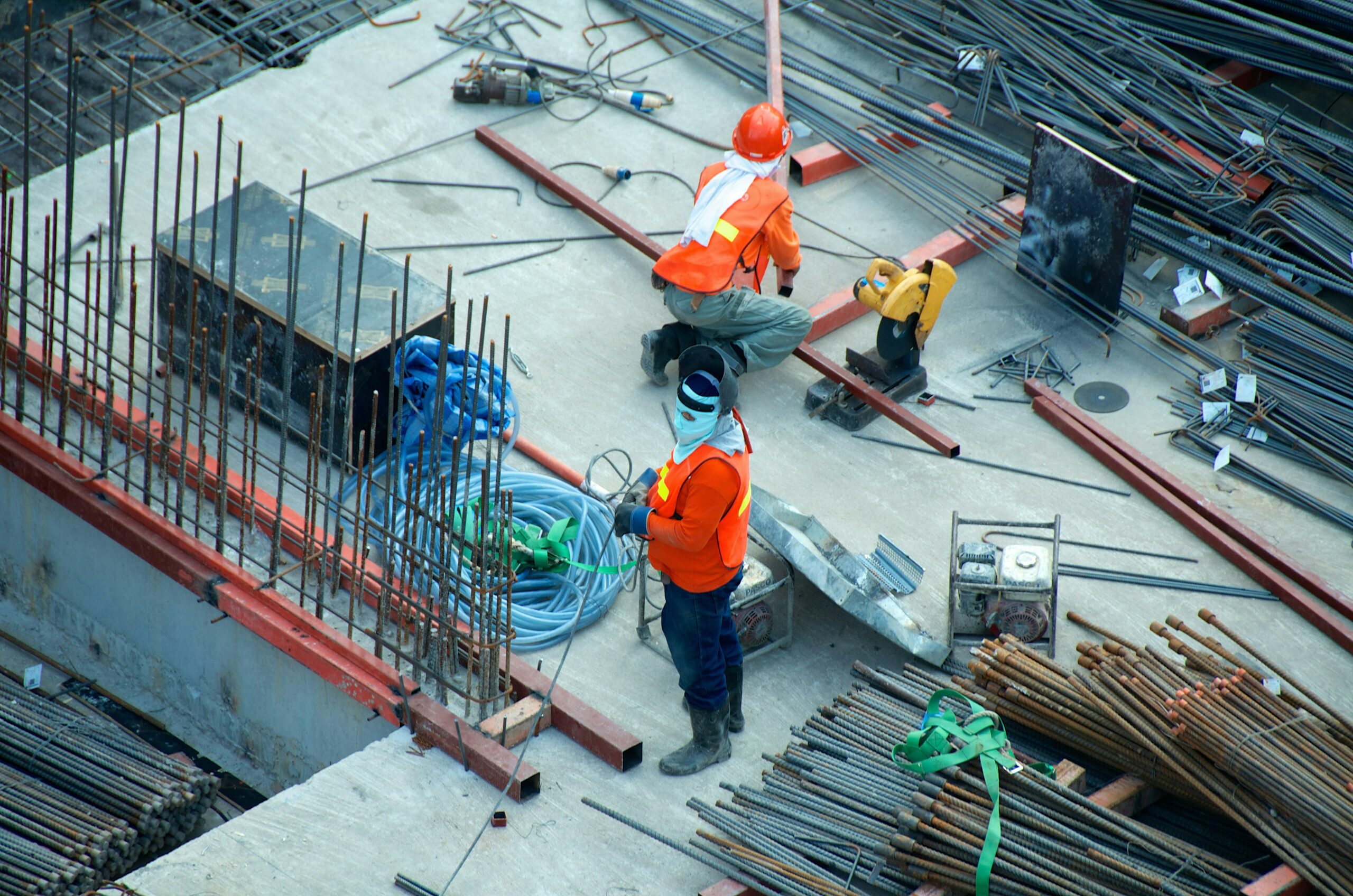This article was originally published in 2021. It was updated in November 2023.
- Half the low-carbon technologies the world needs to reach net zero by 2050 are still in development.
- To accelerate their path to market, the World Economic Forum and John Kerry launched the First Movers Coalition in 2021 at COP26 with just over 30 members.
- Two years on, it’s grown to 95 members who have made 120 commitments to decarbonise the world’s heavy emitting sectors.
It’s been two years since the First Movers Coalition was announced at COP26, and the need to decarbonise the so-called hard-to-abate industries has only become more urgent.
The coalition of companies has more than tripled in membership since it was launched in partnership between the World Economic Forum and US Special Presidential Envoy for Climate John Kerry.
It’s a platform for businesses to commit to buying zero-emission goods and services by 2030, to create demand for low-carbon technologies, make them cost-competitive and build the clean supply chains of the future.
The aim is for these commitments to be “significant enough” that industrial decarbonisation technologies are commercially widespread within the next nine years.
Why Does the First Movers Coalition Need to Create Demand for Clean Tech?
Half the low-carbon technologies the world needs to reach net zero by 2050 – and limit warming to 1.5 degrees – are still in the early development or prototype stages, according to the International Energy Agency.

In total, the First Movers Coalition platform will operate across eight sectors, seven of which are responsible for more than a third of global carbon emissions, but do not have cost-competitive energy alternatives to fossil fuels.
These are: steel, cement, aluminium, chemicals, shipping, aviation and trucking.
It will cost less than 1% of global GDP for these seven industries to go carbon-free by 2050, according to the Energy Transitions Commission. While transitioning to a greener economy could create 24 million jobs, according to the International Labour Organization.
The eighth sector is direct air capture, which could help to reduce levels of carbon dioxide in the atmosphere, but needs greater investment in technological innovation to make it commercially viable.
In order for these technologies to make a difference by 2050, they must be ready to go by 2030.
“Technology has given us the tools to reduce our emissions and build a stronger and more inclusive economy of the future,” Børge Brende, President of the World Economic Forum, said at the launch in 2021, calling on business leaders to join the coalition.
“For innovators and investors to play their part in tackling the climate crisis, they need clear market demand. The First Movers Coalition will leverage the collective purchasing power of leading companies and drive the need for these technologies.”
Which companies are in the First Movers Coalition and what have they committed to?
There are more than 30 founding members of the First Movers Coalition. They are all companies aiming to accelerate innovation through investment in solutions that are essential to achieving the Paris climate goals.
They have all made at least one purchasing commitment to the hard-to-abate phase 1 launch sectors, with the remaining sectors launching early next year:
Aviation
Members have committed to use sustainable aviation fuels and other emerging technologies to significantly decarbonise air travel, avoiding 9.6 million tonnes per year of GHG emissions if the 27 Aviation members meet their targets by 2030. Airlines and airfare and air freight purchasers will replace at least 5% of their conventional jet fuel demand with sustainable aviation fuels that reduce life-cycle emissions by 85% or more, compared with conventional jet fuel and without any offsets. This can be further supported by use of zero-carbon emitting propulsion technologies.
Aluminium
Global aluminium demand will rise by nearly 40% in the next 7 years, according to a CRU International analysis commissioned by the International Aluminum Institute. Decarbonising aluminium while tackling emissions will depend on upscaling primary aluminium production while leveraging new technologies. To that end, FMC’s aluminium sector is sending a strong demand signal for low-carbon primary aluminium produced with less than 3t of CO2 per tonne of primary aluminium, helping to drive the development of a deeply decarbonised product. To meet the growing global demand for aluminium, the FMC is also helping in surfacing the low-carbon secondary, recycled aluminium.
Carbon Dioxide Removals
Carbon Dioxide Removals are increasingly seen as a critical decarbonization tool to offset the hardest-to-abate (last 10% of) emissions. Up to 10 billion tonnes of Carbon dioxide removals per year are expected to be needed by 2050, according to the median estimates of scenarios considered by the IPCC.
The FMC’s Carbon Dioxide Removals sector currently consists of 11 members, each committed to a contract for 50,000 tonnes – or $25 million worth – of durable and scalable CDR by 2030, representing at least 500,000 tonnes of atmospheric CO2 removed.
Cement & Concrete
This year, seven companies joined the cement and concrete sector of the First Movers Coalition (FMC). These firms are from across the value chain, from construction companies to architects, and they have committed to purchasing 10% of their cement and concrete per year as near zero by 2030. Together, the FMC cement and concrete members reflect approximately $60 million in demand. Significantly, they also represent 100,000 tonnes of potential greenhouse gas abatement.
Shipping
First Movers Coalition members from the shipping industry have committed to use zero-emission fuels in new and retrofitted zero emission vessels by 2030. Carriers set a target that at least 5% of their deep-sea shipping will be powered by zero-emission fuels by 2030, enabled by ships capable of using zero-emission fuels. Cargo owners have also set a target that at least 10% of the volume of their goods shipped internationally will be on ships using zero-emission fuels by 2030, on the way to 100% by 2040. Collective efforts from these 16 members will cut GHG emissions by 4.2 million tonnes per year by 2030.
Steel
Deploying breakthrough iron and steelmaking technology is critical to deliver a net-zero steel sector with minimal residual emissions. Such technologies will include hydrogen direct reduction, carbon capture use and storage, and electrolysis-based production processes.
Steel purchasers set a target that at least 10% of their annual steel procurement volumes by 2030 meet or exceed the First Movers Coalition definition for near-zero emissions steel.
Trucking
To create early markets for innovative clean technologies, the 15 trucking-sector members of the First Movers Coalition have committed to purchase or contract zero-emission medium and heavy-duty vehicles, either battery or fuel-cell electric, by 2030. In particular, trucking owners and operators set a target that at least 30% of their heavy-duty and 100% of their medium-duty truck purchases will be zero-emission trucks by 2030. Concurrently, retailers & manufacturers commit to requiring all of their trucking service providers to meet the trucking owners and operators’ commitment by 2030. The realisation of the combined trucking member commitments could cut 0.6 million tonnes of cumulative annual well-to-wheel CO2 emissions by 2030.
The article was first published here.
Photo by Etienne Girardet on Unsplash.

 5.0
5.0 
















